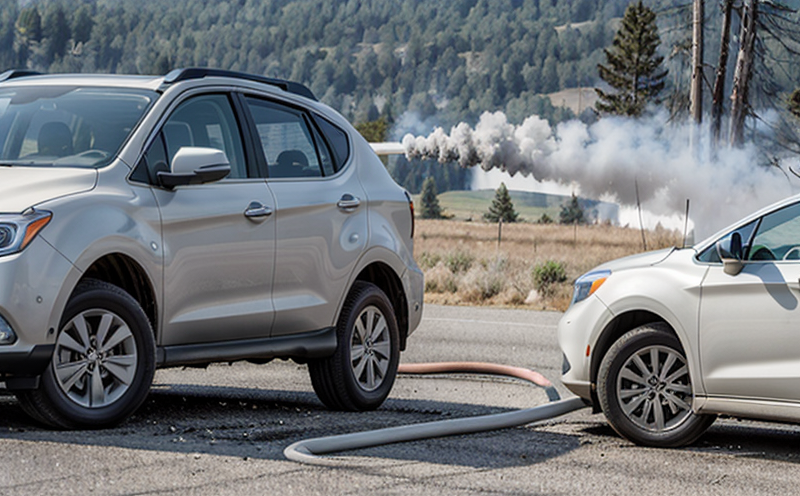Toxicity Index Calculation for Smoke Gases
The calculation of a toxicity index for smoke gases is an essential component in ensuring fire safety and compliance with international standards. The toxicity index provides a quantitative measure of the harmful effects that smoke can have on human health during a fire event. This service involves the comprehensive testing, analysis, and reporting of various toxic constituents present in smoke to generate a toxicity index that helps stakeholders make informed decisions regarding product design, material selection, and regulatory compliance.
The process begins with the collection of representative samples from potential fire scenarios or products under test. These samples are then analyzed using advanced analytical techniques such as gas chromatography-mass spectrometry (GC-MS), Fourier transform infrared spectroscopy (FTIR), and other relevant methods to identify and quantify toxic compounds like carbon monoxide, hydrogen cyanide, ammonia, and others.
Once the components are identified, their concentrations in the smoke are calculated. These values are then used in conjunction with established toxicity models or empirical formulas that account for the relative toxicity of each compound. The models typically incorporate factors such as the concentration of gases, the duration of exposure, and the specific chemical properties of the compounds involved.
The resulting toxicity index provides a single value that summarizes the overall toxic potential of the smoke sample. This index is crucial for several reasons:
- It aids in comparing different materials or products to determine which has lower smoke toxicity.
- It helps in designing fire safety systems and strategies that can mitigate the effects of toxic smoke.
- It supports regulatory compliance by offering a standardized method for assessing smoke toxicity.
The calculation of this index is critical for various stakeholders, including:
- Quality managers who need to ensure product safety and compliance.
- Compliance officers tasked with adhering to international standards like ISO 13952-1:2018 or ASTM E672-18.
- R&D engineers seeking to innovate safer materials and products.
- Procurement teams looking for suppliers who meet stringent fire safety requirements.
The service also includes detailed documentation of the testing process, including a comprehensive report that outlines all findings and recommendations. This document serves as a valuable resource for stakeholders in making informed decisions about product development, material selection, and operational protocols.
Scope and Methodology
The scope of this service includes the following:
- Sampling of smoke from potential fire scenarios or products under test.
- Analysis using advanced analytical techniques such as GC-MS, FTIR, etc., to identify toxic compounds.
- Determination of concentrations of identified toxic compounds in the smoke sample.
- Application of toxicity models or empirical formulas to calculate a single value representing the overall toxic potential (toxicity index) of the smoke.
The methodology employed ensures that the results are accurate, reliable, and consistent with international standards. This includes:
- Use of calibrated instruments and standard operating procedures.
- Inclusion of quality control measures to ensure sample integrity.
- Application of recognized toxicity models or empirical formulas for calculation.
The service aims to deliver actionable insights that can be used to improve product safety and compliance with relevant regulations. By providing a clear understanding of the toxic potential of smoke, this service empowers stakeholders to make informed decisions that prioritize both human health and regulatory requirements.
Why Choose This Test
- Enhanced Safety: Understanding the toxicity of smoke helps in designing safer products and environments.
- Compliance Assurance: This test ensures compliance with international standards like ISO 13952-1:2018, ASTM E672-18, etc.
- Informed Decision-Making: The toxicity index provides a clear metric for comparing different materials and products.
- Regulatory Support: This service supports organizations in meeting regulatory requirements and avoiding costly penalties.
- Research & Development: It aids R&D teams in innovating safer materials and technologies.
- Risk Mitigation: By identifying toxic compounds early, stakeholders can mitigate risks associated with fire safety.
- Customer Satisfaction: Providing a safer product or environment enhances customer trust and satisfaction.
The service is tailored to meet the specific needs of quality managers, compliance officers, R&D engineers, and procurement teams. By offering a comprehensive analysis and actionable insights, this test ensures that stakeholders are well-equipped to make informed decisions regarding fire safety and compliance.
Customer Impact and Satisfaction
The implementation of this service has a significant positive impact on customers in several ways:
- Better Product Safety: Understanding the toxicity of smoke helps manufacturers design safer products, thereby reducing the risk of injury or illness.
- Enhanced Compliance: By ensuring compliance with international standards such as ISO 13952-1:2018 and ASTM E672-18, customers can avoid legal issues and penalties.
- Informed Decision-Making: The toxicity index provides a clear metric for comparing different materials or products, allowing stakeholders to make informed decisions that prioritize safety and compliance.
- Customer Trust: By offering safer products and environments, this service enhances customer trust and satisfaction. This is particularly important in sectors where fire safety is critical, such as residential buildings, commercial properties, and industrial facilities.
- Operational Efficiency: The service helps organizations streamline their operations by providing a standardized method for assessing smoke toxicity, which can lead to cost savings and improved efficiency.
A satisfied customer is one who trusts that the product or environment they are using meets stringent safety standards. By offering this service, we contribute to maintaining high levels of trust among our clients, ensuring that they are well-informed and confident in their choices regarding fire safety.





